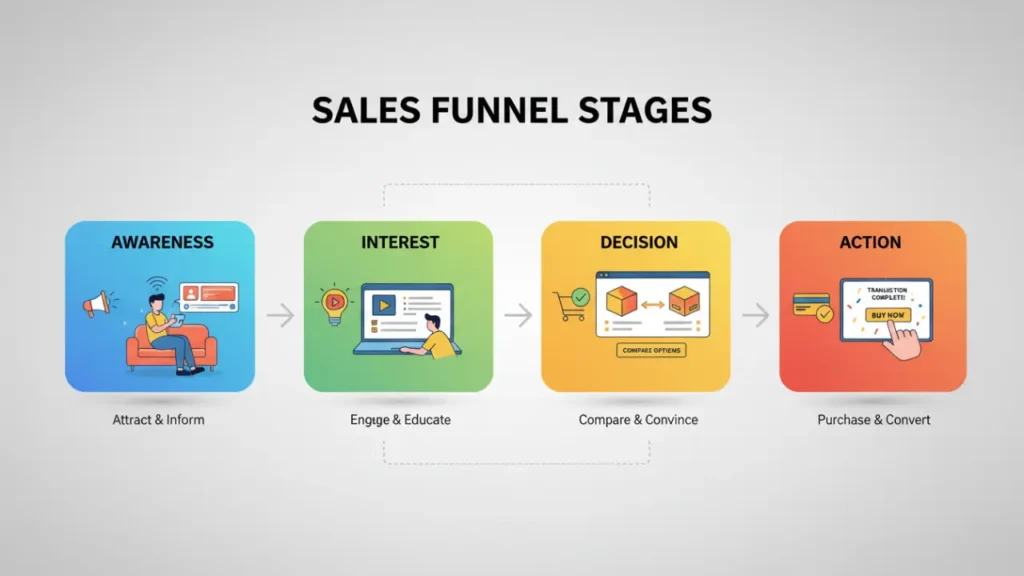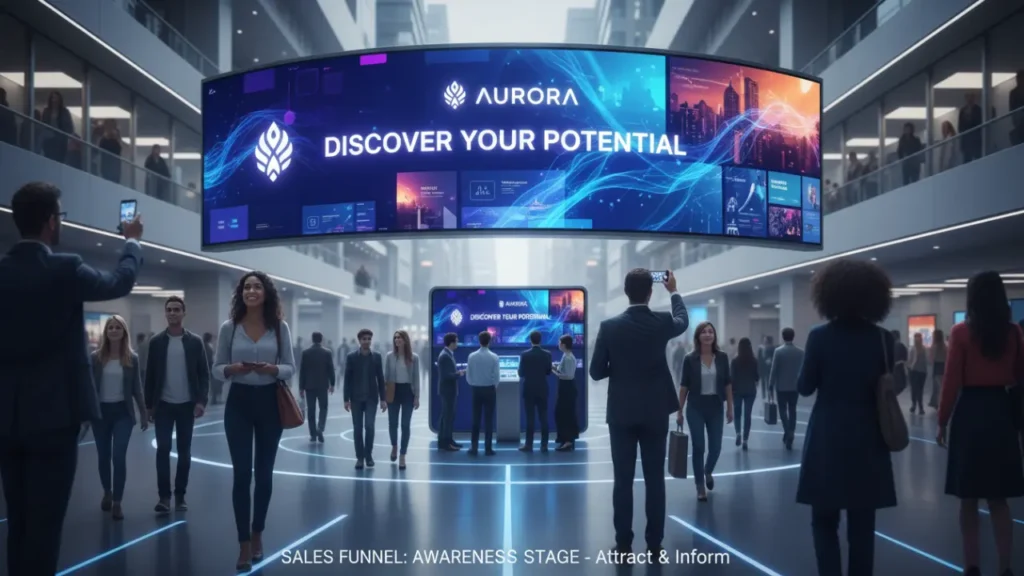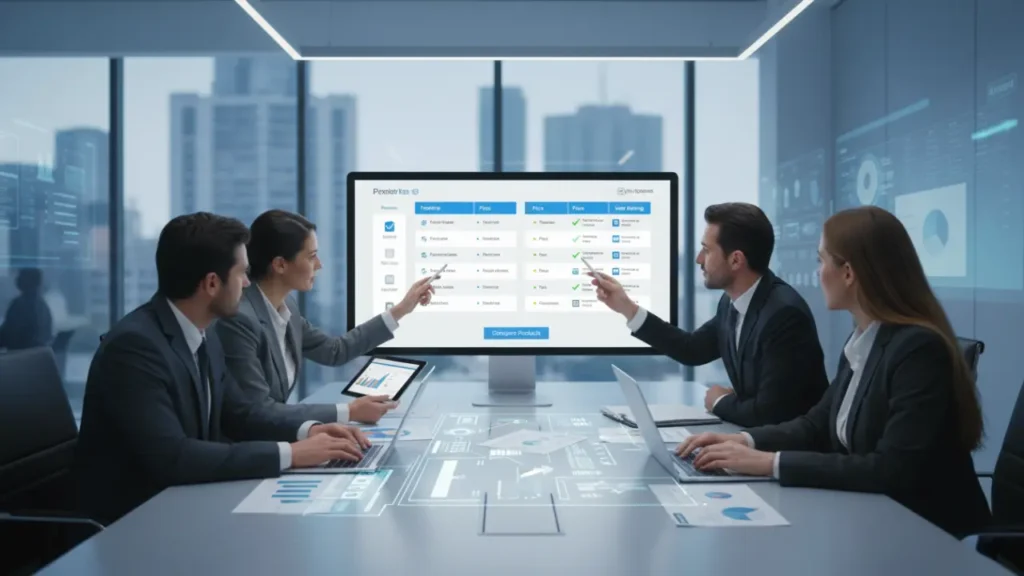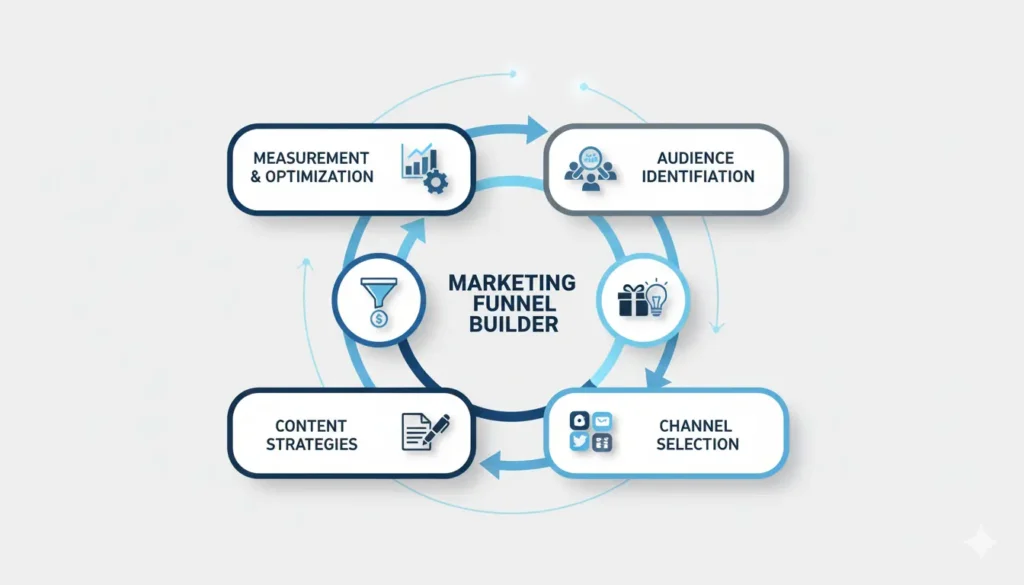What if you could see, step‑by‑step, where people lose interest and fix it before revenue leaks out? That’s the power behind understanding what is a sales funnel. Here’s the curiosity spark: most companies track top‑line traffic and bottom‑line sales but miss the in‑between. In 2025, the teams that grow fastest don’t just run campaigns; they design funnels clear pathways from first touch to repeat purchase and measure each stage like a product.
This definitive guide explains what is a sales funnel in practical, human terms. You’ll get a crisp definition, a detailed walkthrough of each stage, tactics that work now, content examples, metrics that prove ROI, and common mistakes to avoid. Use it to brief your leadership team, align marketing and sales, and turn your website and channels into a compounding revenue system.

Table of Contents
What Is a Sales Funnel? (The Definition You Can Share)
What is a sales funnel? It’s a staged model that maps how strangers move from first touch to loyal customers, showing the steps, friction points, and metrics at each stage so you can improve conversion deliberately. In practical terms, a sales funnel tells you:
- Who you’re attracting and from where
- What people need to see next to keep going
- Where you are losing them (and why)
- Which fixes (content, offers, UX, service) change outcomes
- How attention turns into pipeline, revenue, and repeat purchases
When someone asks “what is a sales funnel” in digital marketing or in a board meeting, the accurate answer is: it’s the system that connects marketing activities to revenue with measurable, improvable steps.
Why 2025 Changes How We Build and Measure Funnels
- Short‑form video shapes first impressions. Your first two seconds matter; hooks, captions, and mobile UX must carry people into the funnel smoothly.
- Search happens across the web and inside social. Top‑of‑funnel content must be discoverable in Google, YouTube, Instagram, TikTok, and LinkedIn.
- Zero‑click behavior is normal. Helpful snippets (FAQs, product data, reviews) often decide before a click; your funnel starts earlier than your website.
- Privacy reshaped tracking. Modeled conversions and aggregated reporting mean funnels must rely on multiple signals, not just last‑click.
- Service and support are part of the funnel. Fast replies in comments, DMs, and chat impact conversion and post‑purchase retention.
Understanding what is a sales funnel in 2025 means planning for multi‑platform discovery, mobile‑first experiences, and measurement that blends platform data with analytics and CRM.
The Classic Stages Explained
A well‑constructed map clarifies what content, offers, and metrics belong where. Here’s a helpful seven‑stage view:
- Awareness — People discover you.
- Interest — They want to know more (light engagement).
- Consideration — They compare options (deeper research).
- Intent — They signal desire (pricing, demos, carts).
- Evaluation — Final checks and internal approvals.
- Purchase — Transaction or signature happens.
- Loyalty/Advocacy — Onboarding, satisfaction, repeat purchases, and referrals.
Awareness

- Goal: Visibility and fit.
- Tactics: SEO content, Reels/Shorts, PR, podcasts, comparison “X vs Y” for early searches.
- Metrics: Impressions, reach, video view‑through rate, brand search volume.
Interest
- Goal: Earn another click and permission to follow up.
- Tactics: Lead magnets (checklists, templates), newsletter signups, product tours.
- Metrics: Click‑through rate (CTR), landing page views, email capture rate.
Consideration

- Goal: Prove you’re the right shortlist choice.
- Tactics: Case studies with numbers, how‑to videos, explainer pages, ROI calculators.
- Metrics: Time on page, scroll depth, demo/consult requests, trial starts.
Intent
- Goal: Make the next step obvious and safe.
- Tactics: Pricing pages, free trials, limited‑time offers, live chat, social proof near CTAs.
- Metrics: Pricing page CTR, cart adds, trial activation, call/chat requests.
Evaluation
- Goal: Remove last obstacles.
- Tactics: FAQs, security/compliance docs, testimonials from similar buyers, side‑by‑side comparisons.
- Metrics: Proposal acceptance, meeting‑to‑close ratio, time in stage.
Purchase
- Goal: Smooth transaction and immediate value.
- Tactics: Fast checkout, friendly confirmation, clear next steps, onboarding guide.
- Metrics: Conversion rate, average order value (AOV), refund/abandon rates.
Loyalty/Advocacy
- Goal: Raise LTV and generate new demand.
- Tactics: Onboarding emails, usage tips, loyalty programs, review/referral requests.
- Metrics: Repeat purchase rate, LTV/CAC, NPS, review volume.
When explaining what is a sales funnel to stakeholders, show this map and attach metrics they already track.
Funnel Models: AIDA, TOFU/MOFU/BOFU, Hourglass
- AIDA (Attention–Interest–Desire–Action): classic and simple; useful for creative.
- TOFU/MOFU/BOFU: top/middle/bottom; helpful for content planning and paid targeting.
- Hourglass: adds Retention and Advocacy beyond purchase; best for subscription and ecommerce.
Choose a model your team can remember. The point is clarity, not jargon.
Building Your Funnel: Audience → Offer → Channels → Content → Conversion → Measurement

Here’s how to go from blank page to working funnel.
Audience (fit first)
- Define your best customers and problem fit.
- Document buyer language and objections from sales calls and support tickets.
Offer (what happens next?)
- Create a clear CTA for each stage: download, subscribe, try, book, buy.
- Add risk reducers: free trials, refunds, demos, price calculators, timelines.
Channels (where to run)
- Start with two strong lanes (e.g., SEO + email; PPC + landing page; Instagram + retargeting; LinkedIn + YouTube for B2B).
- Align creative to channel norms (native formats).
Content (what to show)
- Awareness: short videos, “X vs Y,” list posts, PR mentions.
- Consideration: case studies, tutorials, calculators, webinars.
- Decision: pricing, FAQs, comparison tables, testimonials.
Conversion (don’t waste the click)
- Landing page message match; single CTA; social proof.
- Speed on mobile; short forms; accessible design.
Measurement (proof)
- UTMs on every link; events configured (clicks, form submits, trials, orders).
- Platform + analytics + CRM; compare modeled and click‑through data.
- Dashboards by stage: traffic, engagement, conversion, revenue.
This blueprint turns “what is a sales funnel” from theory into a working system.
Stage‑by‑Stage Playbooks (Tactics, Examples, KPIs)
Awareness Playbook
- SEO: Pillar/cluster blog structure; structured data (FAQ, HowTo, Article).
- Social: Reels/Shorts (one idea per clip), creator collabs, carousels for quick wins.
- PR/Community: data stories, events, helpful posts in niche forums.
Example: A running‑shoe brand posts “Stability vs Neutral Shoes (Which Are You?)” as a short video + blog + carousel; includes a quiz CTA.
KPIs: impressions, view‑through, CTR, new users, brand search volume.
Interest Playbook
- Lead magnets: checklists, templates, calculators; strong landing page design.
- Newsletters: short, useful updates; value before pitch.
- Quizzes: instant feedback and product fit recommendations.
Example: A SaaS company offers a “CRM Migration Checklist” with a 1‑click download and follow‑up emails.
KPIs: landing page conversion rate, email capture rate, cost per lead.
Consideration Playbook
- Case studies: who, what, results, timeline, steps taken; add screenshots.
- How‑to content: 3–5 minute tutorials; embed on relevant pages.
- ROI calc: tie benefits to buyer numbers; export/report feature.
Example: A solar installer publishes “How We Cut AC Costs by 28% Case Snapshot,” with photos and data.
KPIs: demo/consult requests, trial starts, time on page, return visitors.
Intent & Evaluation Playbook
- Pricing page: transparent tiers; feature comparisons; FAQs; “talk to us” option.
- Live chat/DM: fast human replies reduce friction.
- Trust: security statements (B2B), warranties (B2C), customer logos, review snippets.
Example: A clinic’s “What to Expect & Pricing” page includes insurance details, staff intros, and booking link.
KPIs: pricing page CTR, cart adds, meeting‑to‑proposal rate, proposal win rate.
Purchase Playbook
- Checkout UX: guest checkout, minimal fields, preferred payments, auto‑fill.
- Confirmation: clear delivery/next steps; upsell/cross‑sell (tasteful).
- Onboarding: “first 5 minutes” guide; product walkthrough.
Example: An ecommerce brand offers “Add care kit for 15% off” on the confirmation page.
KPIs: conversion rate, AOV, refunds, purchase time.
Loyalty & Advocacy Playbook
- Post‑purchase emails: care tips, setup videos, “complete the set,” review requests.
- Loyalty programs: points, early access, surprise perks.
- Referrals: simple code links; trackable rewards.
Example: A SaaS sends a “90‑day impact recap” and asks for a G2 review; offers a customer spotlight.
KPIs: repeat purchase rate, LTV/CAC, NPS, review volume, referral sales.
Funnels by Business Type
B2B Services
- Top content: frameworks, ROI stories, comparison pages.
- Middle: demos, pilots, workshops, calculators.
- Bottom: proposal templates, reference calls, security docs.
Key metrics: MQL→SQL, SQL→opportunity, opportunity→close, sales cycle length, pipeline velocity.
SaaS
- Top: product‑led content, “X vs Y,” integration guides.
- Middle: free trials, onboarding nurtures, in‑app tours.
- Bottom: pricing clarity, procurement/security info, case studies.
Key metrics: trial activation (Aha moment), PQL conversion, expansion and churn.
Ecommerce/DTC
- Top: UGC and creator demos, Reels/Shorts, comparison pages, buying guides.
- Middle: PDP clarity (FAQs/reviews), email flows, dynamic retargeting.
- Bottom: promo consistency, cart UX, payment options.
Key metrics: add‑to‑cart rate, checkout completion, repeat purchase rate, AOV.
Local Services
- Top: Google Business Profile, before/after reels, neighborhood content.
- Middle: service pages with pricing ranges, “what to expect,” reviews.
- Bottom: instant booking/calls, location pages with parking info.
Key metrics: map pack actions (calls, directions), bookings, review growth.
Content & Creative Ideas That Move People Forward
- Awareness hooks: “I wish I knew this before…,” “3 mistakes with…,” “Watch me fix this in 30s.”
- Consideration frames: “X vs Y,” “How we did [result] in 14 days,” “Budget vs premium what actually changes.”
- Decision proof: “Before/after: timeline + steps,” “Real numbers from real users.”
- Onboarding/love: “Your first 5 minutes,” “Care/maintenance,” “Hidden features,” “Customer spotlight.”
Repurpose: one long demo video → 8 Shorts → 1 carousel → 1 blog → 1 email → snippets for FAQs.
Measurement & Dashboards: Metrics by Stage (With Formulas)
Tie funnel metrics to business outcomes.
Awareness
Reach, impressions, video view rate, brand search volume
Interest
- Landing page conversion rate = leads ÷ visits × 100
- Email signup rate; cost per lead (CPL) = spend ÷ leads
Consideration
Demo/consult request rate; trial starts; return visitor rate
Intent/Evaluation
Pricing page CTR; proposal acceptance; meeting‑to‑close ratio
Purchase
Conversion rate; AOV; CAC (customer acquisition cost) = total sales + marketing spend ÷ customers
Loyalty
Repeat purchase rate; LTV; LTV/CAC; referral rate
Attribution sanity
- Compare platform vs analytics metrics; look for directional trends.
- Use UTMs consistently; annotate major launches and tests.
- Import offline conversions to ad platforms to train targeting.
Tools & Stack (Lean and Useful)
- Analytics & tagging: GA4 (or equivalent), Tag Manager; server‑side tagging where needed
- Search Console: search queries, indexing, enhancements
- Crawlers & speed: Screaming Frog/Sitebulb, PageSpeed Insights
- PPC: native platform reporting, a Looker Studio dashboard
- Email/SMS: automation with segment‑level revenue tracking
- Creative: lightweight editors (CapCut, Descript), Canva/Figma templates
- Review management: request and reply tool (optional)
Tools exist to support a weekly process not to replace it.
Case Snapshots (Anonymized)
SaaS (Mid‑Market)
- Issue: Many trials; few activations.
- Fix: Trial onboarding emails + in‑app tours tied to Aha moment; pricing clarity; security FAQ.
- Result: Activation +27%; trial→paid +9 pts; support tickets −18%.
DTC Apparel
- Issue: Rising CPC; low PDP conversions.
- Fix: Creator try‑on videos; PDP FAQs; Product schema; abandoned cart series.
- Result: PDP CVR +34%; ROAS +28%; repeat purchase +19%.
Local Home Services
- Issue: Low map pack calls; slow site.
- Fix: GBP overhaul; location pages with parking; review request flow; image compression.
- Result: Calls +53%; direction requests +31%; bookings +24%.
These results reflect a clear pattern: map the funnel, remove friction, add proof, and measure by stage.
Frequent Mistakes and Simple Fixes
- Mistake: Starting with channels, not stages.
Fix: Map the funnel first; design content and CTAs per stage. - Mistake: Sending all traffic to the home page.
Fix: Create focused landing pages with single goals. - Mistake: Ignoring mobile speed and UX.
Fix: Compress images, defer scripts, simplify layout; prioritize Core Web Vitals. - Mistake: No UTMs or events.
Fix: Tag every link; set up events for form submits, trials, purchases. - Mistake: Only top‑funnel content.
Fix: Publish comparison pages, case proofs, pricing FAQs, onboarding guides. - Mistake: Last‑click obsession.
Fix: Use platform + analytics + CRM; compare trends; run small lift tests. - Mistake: Treating purchase as the finish line.
Fix: Build post‑purchase flows; ask for reviews/referrals; educate for success.
Each fix strengthens the entire system and that’s exactly how digital marketing helps business.
Conclusion: Make Your Funnel the System That Compounds Growth
If you only remember one idea from this guide, make it this: understanding what is a sales funnel turns guessing into compounding. With a clear map, stage‑specific content, conversion‑focused pages, and clean measurement, you’ll know exactly where to focus next and you’ll be able to prove that your work creates revenue, not just clicks.
Strong funnels do three things consistently:
- Meet people where they are with the next, most helpful step
- Remove friction with clarity, speed, and proof
- Measure by stage and keep what pays
Apply that discipline for a few cycles and the compounding effect becomes your advantage.
Want a High-Converting Sales Funnel That Brings You More Leads & Customers?
A powerful sales funnel can transform your business — turning strangers into leads, and leads into paying customers automatically.
At SparXcellence Ghodke’s LLP, we help businesses build:
✔ Lead generation funnels
✔ Email nurturing automation
✔ High-converting landing pages
✔ Sales funnels for coaching, agencies, e-commerce, real estate & more
✔ Complete funnel setups with ads + content
If you want predictable leads and sales in 2025, you don’t need more traffic —
you need a better funnel.
Book Your FREE Sales Funnel Audit
Get a complete funnel review + action plan for your business.
Schedule here:
https://ghodkes.com/contact-us/
FAQs
What is a sales funnel in one sentence?
It’s a staged map of how people move from first touch to repeat purchase, showing what they need next and where you’re losing them so you can improve conversion deliberately.
How many stages should our funnel have?
Use as many as you need to diagnose problems typically 5–7. Awareness, Interest, Consideration, Intent/Evaluation, Purchase, and Loyalty cover most cases.
What content belongs in each stage?
Awareness: short videos, list posts, PR. Consideration: case studies, how‑tos, calculators. Decision: pricing, FAQs, comparisons, testimonials. Loyalty: onboarding, care, referral prompts.
How do we measure funnel ROI?
Track conversion rates by stage, CAC, LTV, and payback; tie campaigns to revenue via UTMs, analytics, and CRM. Compare platform data with click‑through analytics for a balanced view.
Do small businesses need a sales funnel?
Yes. Even a simple three‑stage funnel (discover→consider→book/buy + post‑purchase) improves consistency and return on every channel.








